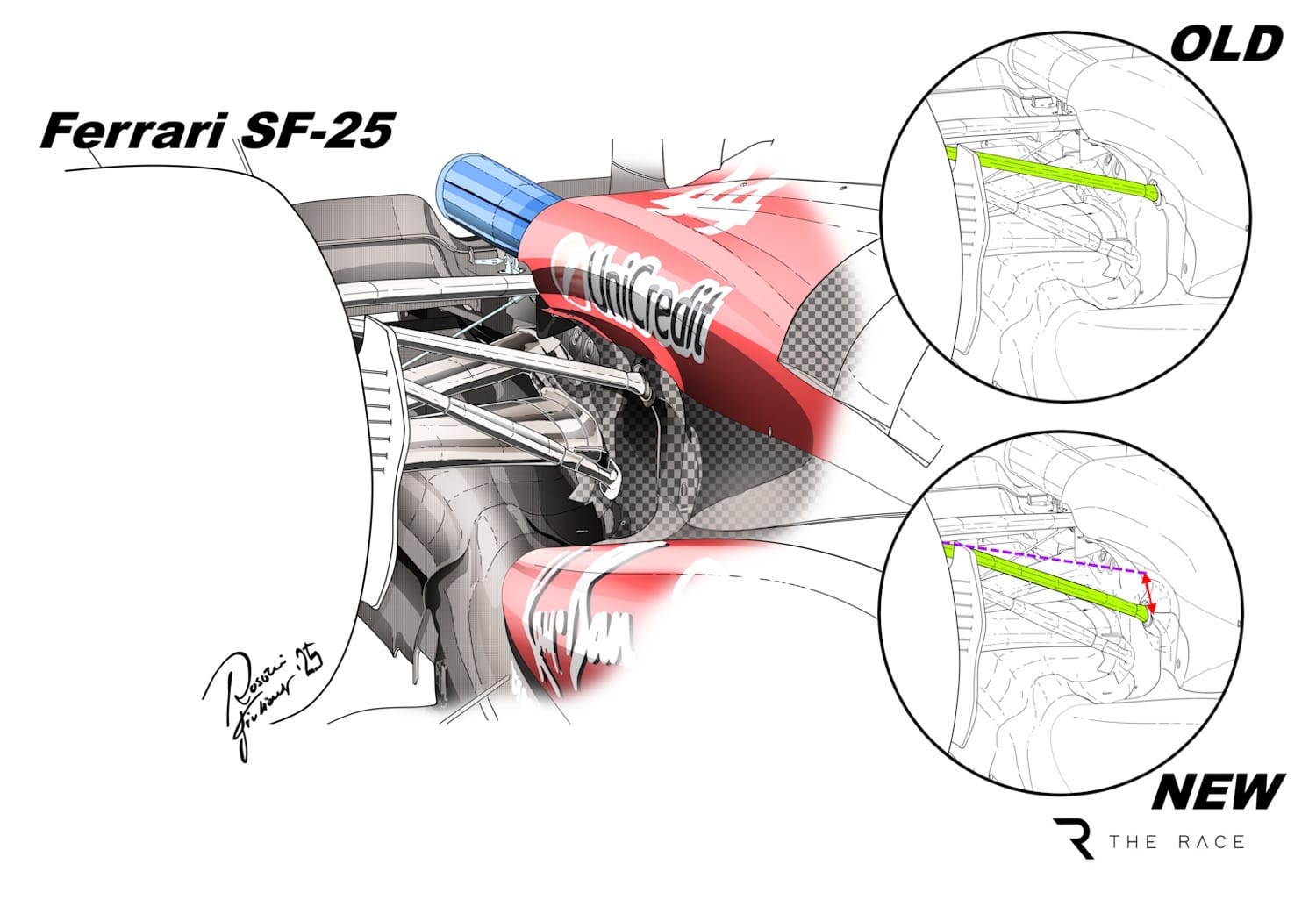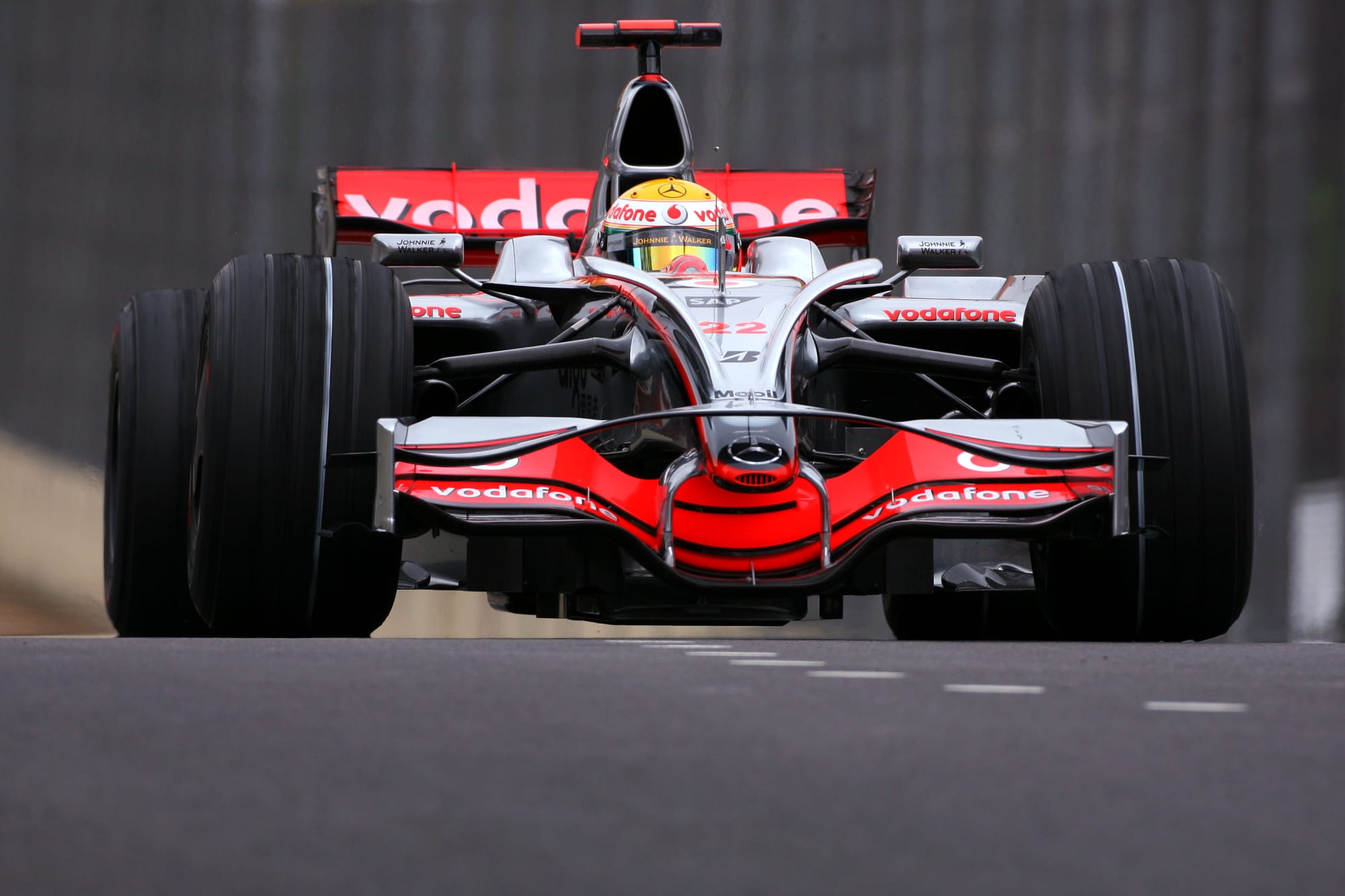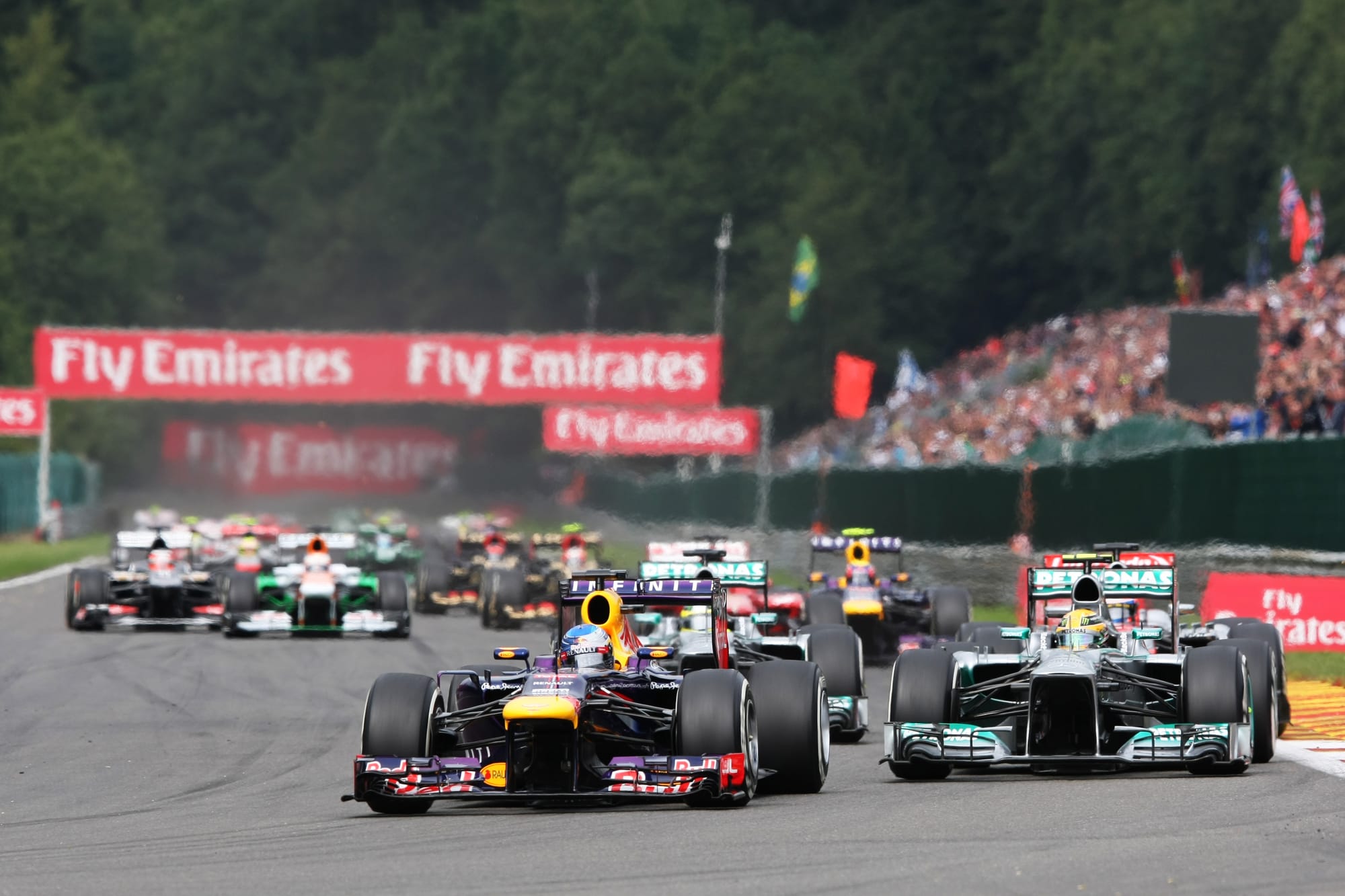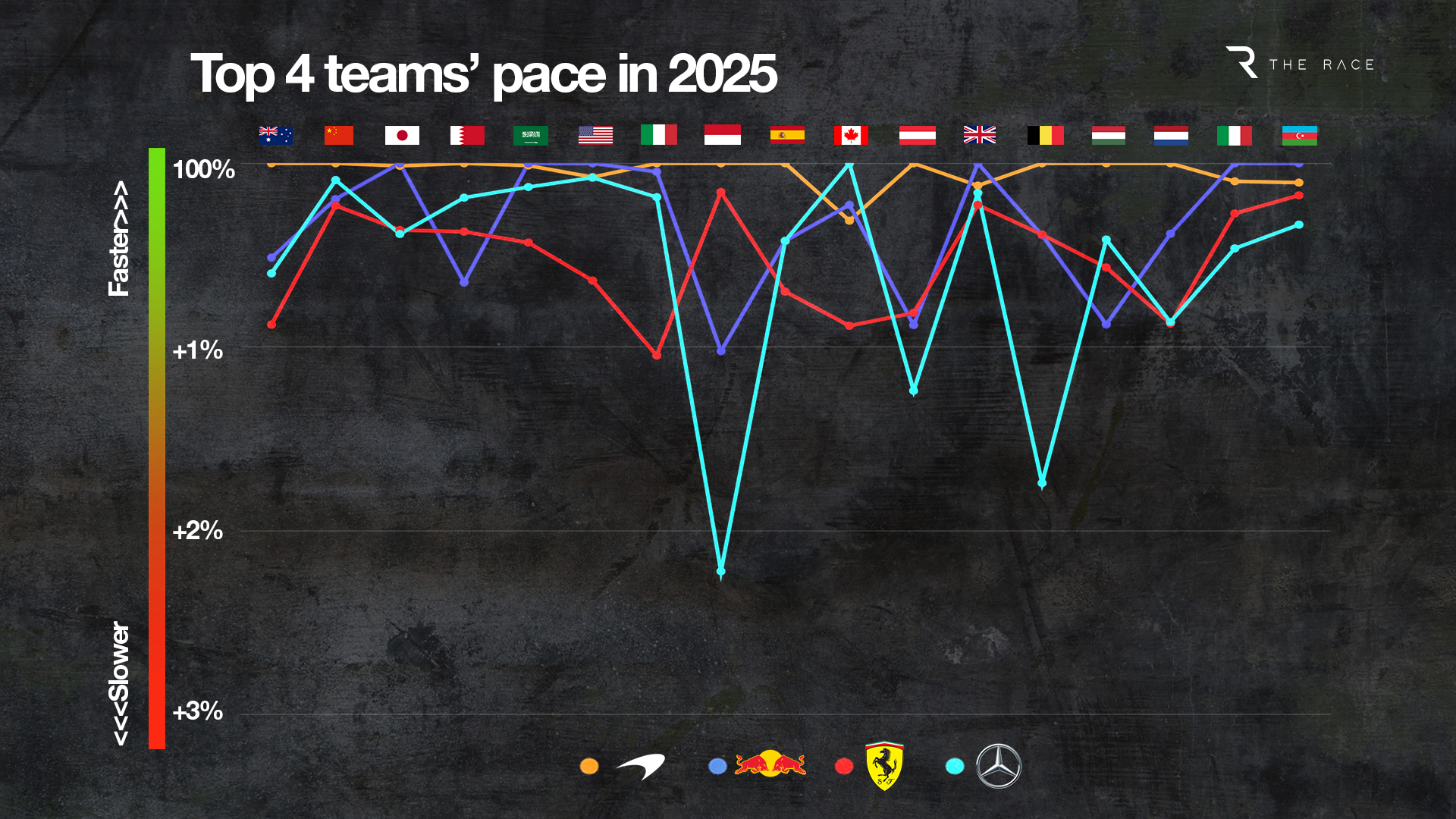Up Next

Lewis Hamilton’s recent suggestion that the 2025 Formula 1 season hasn’t been as exciting as previous final years of regulations because of the budget cap is a curious claim.
Hamilton said 2025 “feels quite a bit different because of the budget cap," which was introduced in 2021, compared to other seasons that directly preceded major regulation changes like 2008 and 2013. He reckons teams' new financial limits have stymied the degree to which they can do parallel development problems and forced them to barely upgrade their 2025 cars, making this season less varied and exciting.
“I remember in 2008 when we [McLaren] were still able to bring upgrades in that year, we were still fighting, we were still developing the car right to the end, and obviously the next year's car was a disaster, but they would have to do those two in tandem,” Hamilton recalled in Baku.
“And then in 2013, again, I was switching [he'd joined Mercedes from McLaren for 2013], so it's difficult to say so much in that section, but I would say this time it's not been as exciting because we've moved over [design focus] so early, and so you then just stuck with what you have for the year.
“So it makes this season less exciting because you're not getting developments, so just going to see out the rest of the year with what you have, but then next year will be an exciting one because there'll be lots of upgrades throughout.”
So is Hamilton right?
The caveats

Firstly it’s important to remember the context of Hamilton’s comments. He’s laser-focused on Ferrari’s efforts, and he hasn’t seen the development progress he’d have hoped.
Ferrari has brought new parts - a new floor in Austria at the end of June and new rear suspension for Belgium a month later (pictured above) - but they haven’t exactly lifted Ferrari up the pecking order.
There have been more podiums for Hamilton’s team-mate Charles Leclerc, but it’s remained around the same distance adrift of McLaren all season, alternating with Red Bull (and sometimes Mercedes) as its closest challenger depending on the track and how low Ferrari's able to run its car around its well-documented ride height problem.
So it’s understandable why, personally, for Hamilton, it won’t have felt as exciting as Ferrari’s remained at a frustrating arm’s length away from McLaren.
And with only minor upgrade tweaks for the rest of the year, that pecking order is highly unlikely to change over the last seven events, with Ferrari very much stuck making the most of the car it has right now.
Hamilton is not necessarily talking about the F1 season as a whole being less exciting for a neutral point of view - why would he be interested in the progress Sauber or Aston Martin has made? So, from where he’s sitting, being stuck in a car that’s already been beaten to the constructors’ title with seven rounds to spare, isn’t the most enthralling challenge.
Especially when you compare it to the 2008 and 2013 seasons that Hamilton is comparing 2025 with…
Do Hamilton's 2008 and 2013 comparisons stack up?

Hamilton rightly points to 2008 as a year where F1’s development race didn’t let up, with his McLaren team bringing upgrades right up until the end of the year.
Hamilton’s 2008 team-mate Heikki Kovalainen’s chief mechanic Jonathan Brookes recalled “you would always injure yourself on the car because there were so many aero bits sticking out. Parts were constantly changing”.
That was because McLaren was locked in a neck-and-neck title fight with Ferrari, with both teams continuing to bring upgrades to their cars despite the looming huge aerodynamic regulation overhaul for 2009 - something both, for somewhat related reasons, got badly wrong.
And BMW Sauber and Robert Kubica famously removed themselves from the title fight, as BMW switched off the 2008 development taps soon after Kubica picked up his and the team’s maiden win in Montreal - a decision Kubica still believes cost him a shot at the 2008 title, and didn't exactly help him out for a 2009 season where he only stood on the podium once.
The clear difference with 2025 is not just the budget cap being in place, but the fact that McLaren and its drivers are having such a dominant ride to the two titles (even if Max Verstappen's recent surge might be changing that a little). That also makes it different to 2021 when title rivals Red Bull and Mercedes kept a high development rate with some cost to their 2022 projects - and that was done during the first year of the budget cap.
You’d have to imagine things would be different if McLaren was facing big competition from Ferrari, Red Bull (earlier than Monza) or Mercedes, even with the looming 2026 regulations.
McLaren’s been afforded the chance to switch focus to 2026 in good time and its rivals, clearly beaten since the start of the European season, have been able to do the same.
The 2013 comparison is perhaps a stronger one. Red Bull dominated the second half of that season. Securing both titles was something of a formality even before Sebastian Vettel’s nine-race winning streak properly got going.
The pecking order did change versus the start of the season, but that had more to do with the mid-season change in Pirelli compound following a blowout-strewn British Grand Prix and Red Bull’s own strong in-season development.

Mercedes was having a rollercoaster season too as it grappled to understand why it had a car that could take regular pole positions but melt its tyres in the races - only three out of eight poles were converted into race wins.
So the Mercedes did change through 2013, but it also still firmly had one eye on 2014, arguably putting resources into the ‘14 car earlier than any other team.
So teams looking ahead to next year’s regulations and slowing down development in the final year of the regulations has always been a factor, not just in 2025.
'I don't think it's a limitation'
In 2025 there have still been pecking order shifts, even if McLaren has more or less maintained its advantage throughout - pending confirmation in Singapore of how much of a step Red Bull has taken - and Ferrari has remained relatively static.

The most obvious example of that is Red Bull's recent turnaround, in part helped by its Italian GP upgrade package.
On Sunday in Baku even Hamilton was in awe of the step Red Bull has made and said of his Ferrari's circumstance: "I would give anything for an upgrade, but obviously we don't have that, because we've been focused on next year's car."
Behind McLaren and Red Bull, Sauber was able to transform itself from F1’s slowest team to put itself right into the thick of F1’s medium and even snatch an unlikely podium.
The Race put Hamilton’s comments about stagnant development to Sauber boss Jonathan Wheatley, who replied: “We’ve got a fantastic championship this year, haven’t we?
“We’ve got the pack separated often by eight tenths of a second in the first period of qualifying. I do feel it’s just a natural coming together of a set of technical regulations that have been relatively stable for a certain period of time.
“I’d say from my team’s perspective, I’ve been very encouraged by how we found performance on a car that was struggling a little bit at the beginning of the year, and we’ve turned it around in such a tight field.
“But I think it’s more a factor that the technical regulations have been stable for a while.”
McLaren team boss Andrea Stella was quick to praise the budget cap too and doesn’t believe it’s been a limitation to in-season development.
“I would add that the budget cap is one of the most important aspects of the regulations that we have in place to guarantee the health and the viability of the sport,” Stella said.
“So I think it’s important we remark that. At the same time, let me say that, for instance, we at McLaren have been able to make a decent step forward under the budget cap, because I think ultimately you can find performance not only from a financial point of view, but also from a technical point of view.
“So I don’t think the budget cap is a limitation.”
It hasn’t brought as big packages as it did in 2023 and 2024, but McLaren’s more surgical, smaller approach has proved effective in keeping its advantage.
The main differentiator appears to be the success (or failure) of the upgrades teams have brought in 2025 - even if they’re at a smaller rate than, say, 2024.
Teams such as McLaren, Red Bull, Aston Martin and Sauber have been buoyed by their upgrades working, whereas teams such as Ferrari and Mercedes - which had to U-turn twice on the suspension it debuted at Imola in May before finally binning it for good after Spa two months later - have struggled to make development gains.
The budget cap didn’t decide any of that, apart from perhaps teams not being able to throw endless money at solutions. When upgrades like the Mercedes suspension fail, it’s not like the teams have the resources to design and produce a replacement like they may have been able to in the past.
So if the pecking order is set for the rest of 2025, firstly, it’s set into an interestingly close pattern that varies from track-to-track at least, and secondly, it’s far more a reflection of who has and hasn’t got it right, than a limitation of the budget cap.



